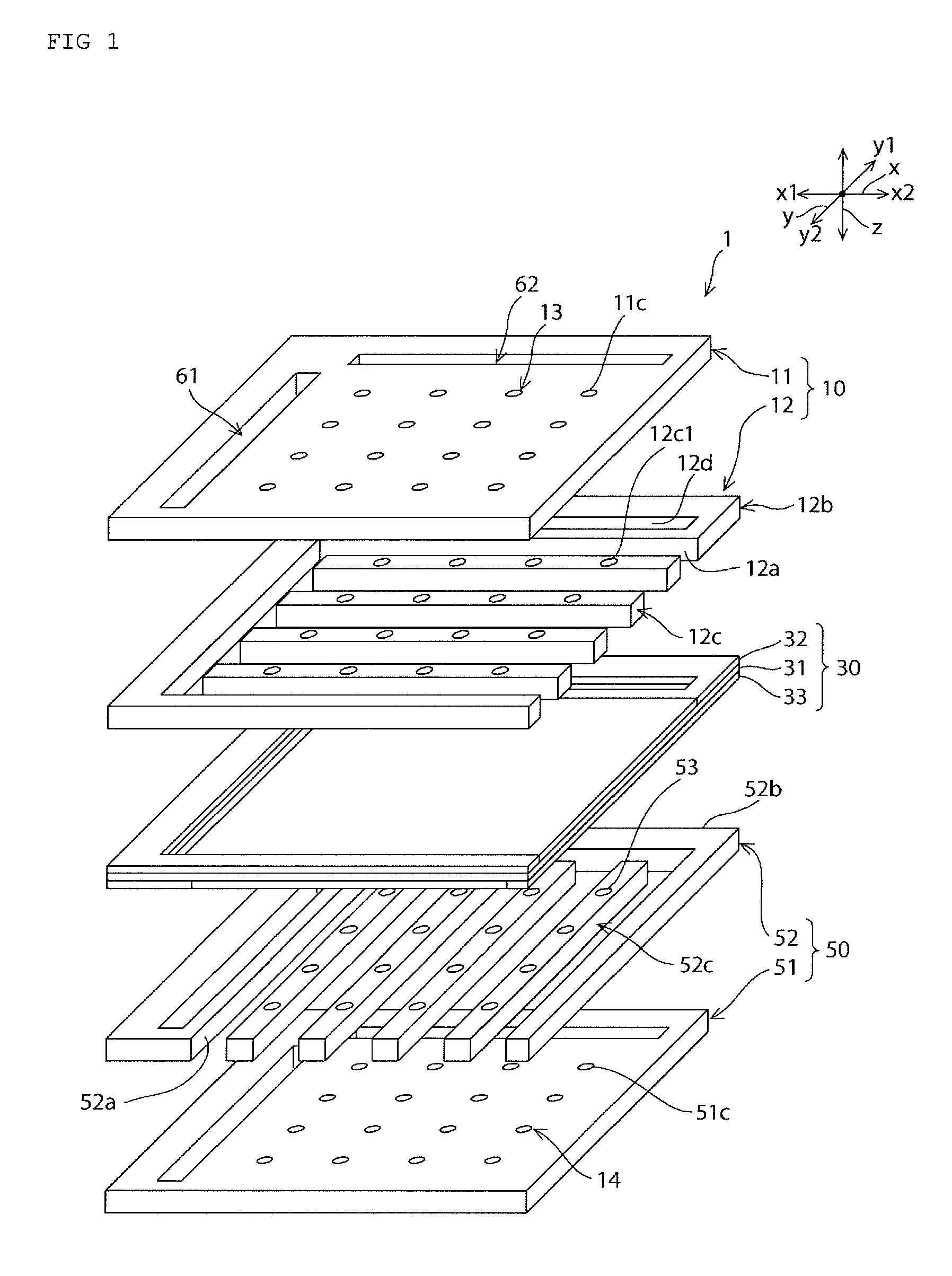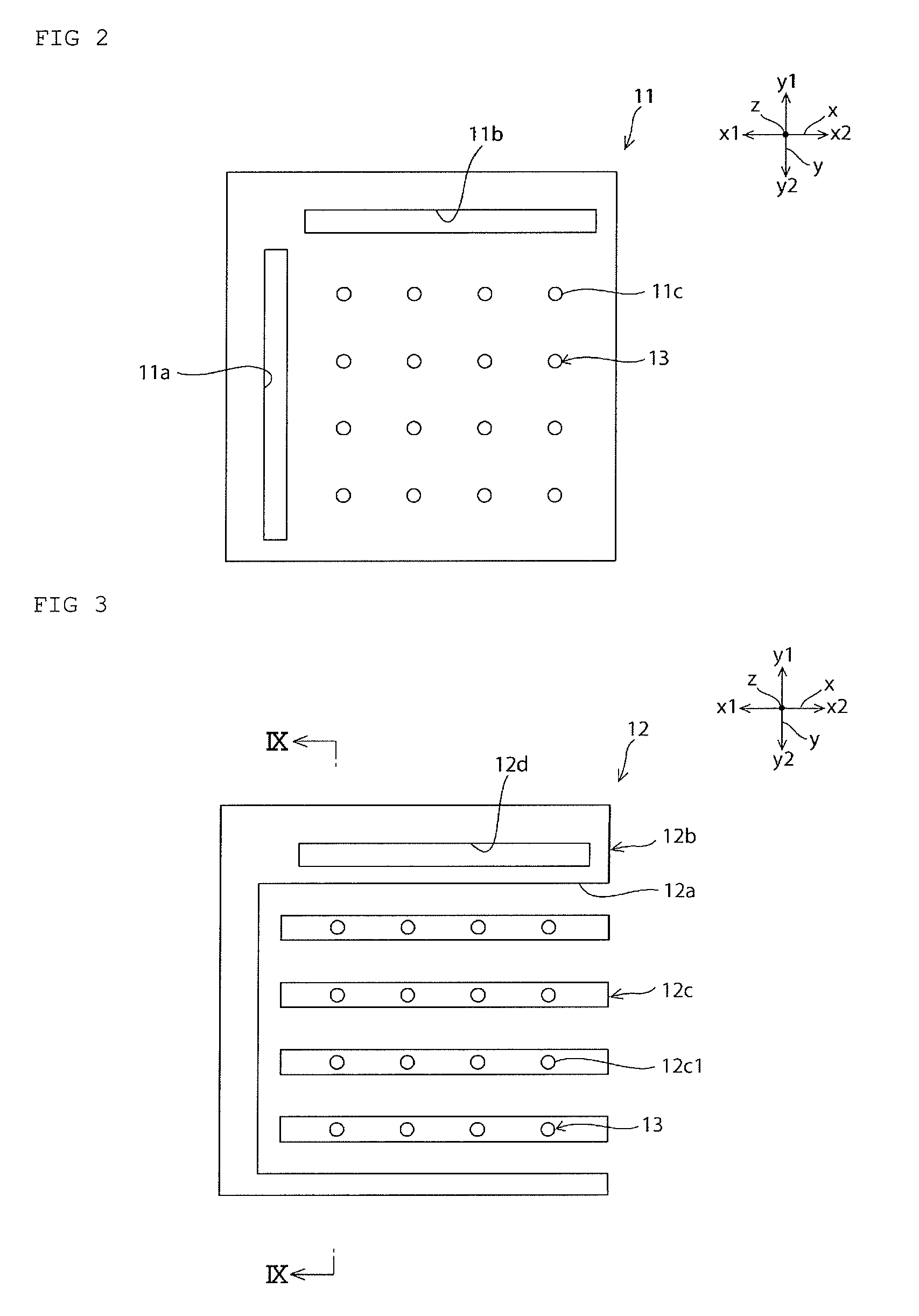Fuel cell
a fuel cell and electrode technology, applied in the field of fuel cells, can solve the problems of degrading the electrical connection between the fuel electrode and the interconnector, and the product life cannot be made sufficiently long, and achieve the effect of long product li
- Summary
- Abstract
- Description
- Claims
- Application Information
AI Technical Summary
Benefits of technology
Problems solved by technology
Method used
Image
Examples
experimental example 2
[0089]SrTiO3, CaTiO3 and Nb2O5 were stoichiometrically weighed so as to lead to (Sr1-xCax)0.9(Ti0.9Nb0.1)O3 (where x is 0, 0.4, 0.6, 0.8 or 1.0), ground and mixed in water using zirconia balls, and the mixture was dried. Thereafter, the mixture was fired at 850° C. for 4 hours. Next, the fired product was ground in water using zirconia balls having a diameter of 5 mm to obtain a ceramic powder. The ceramic powder, an organic solvent and a butyral-based binder were mixed to prepare a slurry. The slurry was molded into a sheet shape using a doctor blade method. Thereafter, the obtained sheet was fired at 1150° C. for 6 hours to obtain a ceramic sheet.
[0090]The density of the obtained ceramic sheet was measured. The results are shown by triangles in the graph shown in FIG. 14.
[0091]From the results shown in FIG. 14, it is apparent that when 0.5≦x≦0.9, the density can be increased. On the other hand, it is apparent that when 0≦x<0.5, the density can be decreased.
experimental example 3
[0092]SrTiO3, CaTiO3 and Nb2O5 were stoichiometrically weighed so as to lead to (Sr0.2Ca0.8)z(Ti1-yNby)O3 (where z is 1−y, i.e. 0.91, 0.873, 0.83 or 0.77, and y is 0.09, 0.127, 0.17 or 0.23), ground and mixed in water using zirconia balls, and the mixture was dried. Thereafter, the mixture was fired at 850° C. for 4 hours. Next, the fired product was ground in water using zirconia balls having a diameter of 5 mm to obtain a ceramic powder. The ceramic powder, an organic solvent and a butyral-based binder were mixed to prepare a slurry. The slurry was molded into a sheet shape using a doctor blade method. Thereafter, the obtained sheet was fired at 1170° C. for 6 hours to obtain a ceramic sheet.
[0093]The density of the obtained ceramic sheet was then measured. The results are shown in FIG. 15.
[0094]From the results shown in FIG. 15, it is apparent that a change of y does not cause a significant change in density.
experimental example 4
[0095]SrTiO3, CaTiO3 and Nb2O5 were stoichiometrically weighed so as to lead to (Sr0.2Ca0.8)z(Ti0.9Nb0.1)O3 (where z is 0.920, 0.927, 0.936, 0.955 or 1.000), ground and mixed in water using zirconia balls, and the mixture was dried. Thereafter, the mixture was fired at 850° C. for 4 hours. Next, the fired product was ground in water using zirconia balls having a diameter of 5 mm to obtain a ceramic powder. The ceramic powder, SrTiO3, CaTiO3, an organic solvent and a butyral-based binder were mixed to prepare a slurry. The slurry was molded into a sheet shape using a doctor blade method. Thereafter, the obtained sheet was fired at 1150° C. for 6 hours to obtain a ceramic sheet.
[0096]The density of the obtained ceramic sheet was measured. The results are shown in FIG. 16.
[0097]From the results shown in FIG. 16, it is apparent that when z is less than 0.95, the density can be increased. On the other hand, it is apparent that when z is 0.95 or more, the density can be decreased.
[0098]Fr...
PUM
| Property | Measurement | Unit |
|---|---|---|
| temperature | aaaaa | aaaaa |
| temperature | aaaaa | aaaaa |
| diameter | aaaaa | aaaaa |
Abstract
Description
Claims
Application Information
 Login to View More
Login to View More - R&D
- Intellectual Property
- Life Sciences
- Materials
- Tech Scout
- Unparalleled Data Quality
- Higher Quality Content
- 60% Fewer Hallucinations
Browse by: Latest US Patents, China's latest patents, Technical Efficacy Thesaurus, Application Domain, Technology Topic, Popular Technical Reports.
© 2025 PatSnap. All rights reserved.Legal|Privacy policy|Modern Slavery Act Transparency Statement|Sitemap|About US| Contact US: help@patsnap.com



